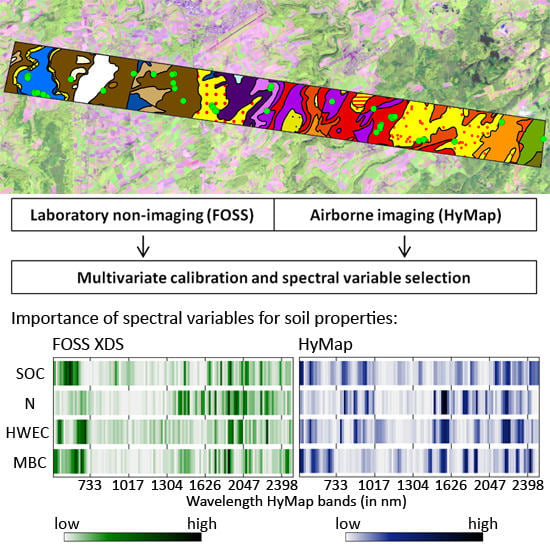Quantification of Soil Properties with Hyperspectral Data: Selecting Spectral Variables with Different Methods to Improve Accuracies and Analyze Prediction Mechanisms
Abstract
:1. Introduction
2. Materials and Methods
2.1. Study Site, Soil Samples and Their Analytical Properties
2.2. Spectral Database
- -
- conversion of digital numbers to at-sensor-radiances using laboratory and in-flight radiometric calibration data provided by HyVista Corporation (Baulkham Hills, Australia),
- -
- atmospheric correction to provide surface reflectances with the airborne ATCOR® (ATCOR-4, German Aerospace Center DLR, Weßling, Germany) software based on the MODTRAN® (MODerate resolution atmospheric TRANsmission) computer code,
- -
- parametric geocoding with the PARGE® (ReSe Applications Schläpfer, Wil, Switzerland) software, that directly supports the processing of HyMap data and integrates flight parameters, terrain information and ground control reference points,
- -
- cross-track illumination correction (excluding forested and clouded areas) implemented in ENVITM (ENvironment for Visualizing Images, Harris Geospatial Solutions, Broomfield, CO, USA) using a second order polynomial approach.
2.3. Multivariate Calibrations of OC, N, MBC and HWEC from Spectral Measurements
2.4. Indirect Assessment of MBC and HWEC from OC, N and with Modelled Spectra
3. Results
3.1. Estimation Results for Soil Variables from Measured Spectra
3.2. Analysis of Selection Patterns
3.3. Indirect Approaches to Quantify HWEC and MBC
4. Discussion
5. Conclusions
Acknowledgments
Author Contributions
Conflicts of Interest
References
- Cécillon, L.; Barthès, B.G.; Gomez, C.; Ertlen, D.; Genot, V.; Hedde, M.; Stevens, A.; Brun, J.J. Assessment and monitoring of soil quality using near-infrared reflectance spectroscopy (NIRS). Eur. J. Soil Sci. 2009, 60, 770–784. [Google Scholar] [CrossRef]
- Chabrillat, S.; Goetz, A.F.H.; Krosley, L.; Olsen, H.W. Use of hyperspectral images in the identification and mapping of expansive clay soils and the role of spatial resolution. Remote Sens. Environ. 2002, 82, 431–434. [Google Scholar] [CrossRef]
- Franceschini, M.H.D.; Demattê, J.A.M.; da Silva Terra, F.; Vicente, L.E.; Bartholomeus, H.; de Souza Filho, C.R. Prediction of soil properties using imaging spectroscopy: Considering fractional vegetation cover to improve accuracy. Int. J. Appl. Earth Obs. 2015, 38, 358–370. [Google Scholar]
- Wight, J.P.; Ashworth, A.J.; Allen, F.L. Organic substrate, clay type, texture, and water influence on NIR carbon measurements. Geoderma 2016, 261, 36–43. [Google Scholar] [CrossRef]
- Gomez, C.; Lagacherie, P.; Coulouma, G. Regional predictions of eight common soil properties and their spatial structures from hyperspectral Vis-NIR data. Geoderma 2012, 189–190, 176–185. [Google Scholar] [CrossRef]
- Hbirkou, C.; Pätzold, S.; Mahlein, A.K.; Welp, G. Airborne hyperspectral imaging of spatial soil organic carbon heterogeneity at the field scale. Geoderma 2012, 175–176, 21–28. [Google Scholar] [CrossRef]
- Selige, T.; Böhner, J.; Schmidhalter, U. High resolution topsoil mapping using hyperspectral image and field data in multivariate regression modeling procedures. Geoderma 2006, 136, 235–244. [Google Scholar] [CrossRef]
- Steinberg, A.; Chabrillat, S.; Stevens, A.; Segl, K.; Foerster, S. Prediction of common surface soil properties based on Vis-NIR airborne and simulated EnMAP imaging spectroscopy data: Prediction accuracy and influence of spatial resolution. Remote Sens. 2016, 8, 613. [Google Scholar] [CrossRef]
- Stevens, A.; van Wesemael, B.; Bartholomeus, H.; Rosillon, D.; Tychon, B.; Ben-Dor, E. Laboratory, field and airborne spectroscopy for monitoring organic carbon content in agricultural soils. Geoderma 2008, 144, 395–404. [Google Scholar] [CrossRef]
- Lagacherie, P.; Baret, F.; Feret, J.-B.; Madeira Netto, J.; Robbez-Masson, J.-M. Estimation of soil clay and calcium carbonate using laboratory, field and airborne hyperspectral measurements. Remote Sens. Environ. 2008, 112, 825–835. [Google Scholar] [CrossRef]
- Ben-Dor, E.; Patkin, K.; Banin, A.; Karnieli, A. Mapping of several soil properties using DAIS-7915 hyperspectral scanner data—A case study over clayey soils in Israel. Int. J. Remote Sens. 2002, 23, 1043–1062. [Google Scholar] [CrossRef]
- Chang, C.W.; Laird, D.A.; Mausbach, M.J.; Hurburgh, C.R.J. Near-infrared reflectance spectroscopy–principal components regression analyses of soil properties. Soil Sci. Soc. Am. J. 2001, 65, 480–490. [Google Scholar] [CrossRef]
- Chodak, M. Near-infrared spectroscopy for rapid estimation of microbial properties in reclaimed mine soils. J. Plant Nutr. Soil Sci. 2011, 174, 702–709. [Google Scholar] [CrossRef]
- Heinze, S.; Vohland, M.; Joergensen, R.G.; Ludwig, B. Usefulness of near-infrared spectroscopy for the prediction of chemical and biological soil properties in different long-term experiments. J. Plant Nutr. Soil Sci. 2013, 176, 520–528. [Google Scholar] [CrossRef]
- Terhoeven-Urselmans, T.; Schmidt, H.; Joergensen, R.G.; Ludwig, B. Usefulness of near-infrared spectroscopy to determine biological and chemical soil properties: Importance of sample pre-treatment. Soil Biol. Biochem. 2008, 40, 1178–1188. [Google Scholar] [CrossRef]
- Zornoza, R.; Guerrero, C.; Mataix-Solera, J.; Scow, K.M.; Arcenegui, V.; Mataix-Beneyto, J. Near infrared spectroscopy for determination of various physical, chemical and biochemical properties in Mediterranean soils. Soil Biol. Biochem. 2008, 40, 1923–1930. [Google Scholar] [CrossRef] [PubMed]
- Bastida, F.; Zsolnay, A.; Hernández, T.; García, C. Past, present and future of soil quality indices: A biological perspective. Geoderma 2008, 147, 159–171. [Google Scholar] [CrossRef]
- Ritz, K.; Black, H.I.J.; Campbell, C.D.; Harris, J.A.; Wood, C. Selecting biological indicators for monitoring soils: A framework for balancing scientific and technical opinion to assist policy development. Ecol. Indic. 2009, 9, 1212–1221. [Google Scholar] [CrossRef] [Green Version]
- Pulleman, M.; Creamer, R.; Hamer, U.; Helder, J.; Pelosi, C.; Pérès, G.; Rutgers, M. Soil biodiversity, biological indicators and soil ecosystem services—An overview of European approaches. Curr. Opin. Sust. 2012, 4, 529–538. [Google Scholar] [CrossRef] [Green Version]
- Velasquez, E.; Lavelle, P.; Andrade, M. GISQ, a multifunctional indicator of soil quality. Soil Biol. Biochem. 2007, 39, 3066–3080. [Google Scholar] [CrossRef]
- Havlicek, E. Soil biodiversity and bioindication: From complex thinking to simple acting. Eur. J. Soil Biol. 2012, 49, 80–84. [Google Scholar] [CrossRef]
- Böhme, L.; Langer, U.; Böhme, F. Microbial biomass, enzyme activities and microbial community structure in two European long-term field experiments. Agric. Ecosyst. Environ. 2005, 109, 141–152. [Google Scholar] [CrossRef]
- Fließbach, A.; Oberholzer, H.-R.; Gunst, L.; Mäder, P. Soil organic matter and biological soil quality indicators after 21 years of organic and conventional farming. Agric. Ecosyst. Environ. 2007, 118, 273–284. [Google Scholar] [CrossRef]
- Hoyle, F.C.; Murphy, D.V.; Fillery, I.R.P. Temperature and stubble management influence microbial CO2-C evolution and gross transformation rates. Soil Biol. Biochem. 2006, 38, 71–80. [Google Scholar] [CrossRef]
- Lundquist, E.J.; Scow, K.M.; Jackson, L.E.; Uesugi, S.L.; Johnson, C.R. Rapid response of soil microbial communities from conventional, low input, and organic farming systems to a wet/dry cycle. Soil Biol. Biochem. 1999, 31, 1661–1675. [Google Scholar] [CrossRef]
- Moscatelli, M.C.; Lagomarsino, A.; Marinari, S.; De Angelis, P.; Grego, S. Soil microbial indices as bioindicators of environmental changes in a poplar plantation. Ecol. Indic. 2005, 5, 171–179. [Google Scholar] [CrossRef]
- Jenkinson, D.S.; Ladd, J.N. Microbial biomass in soil; measurement and turnover. In Soil Biochemistry; Paul, E.A., Ladd, J.N., Eds.; Dekker, Inc.: New York, NY, USA, 1981; Volume 5, pp. 415–471. [Google Scholar]
- Schulz, E.; Körschens, M. Characterization of the decomposable part of soil organic matter (SOM) and transformation processes by hot water extraction. Eurasian Soil Sci. 1998, 31, 809–813. [Google Scholar]
- Chantigny, M.H. Dissolved and water-extractable organic matter in soils: A review on the influence of land use and management practices. Geoderma 2003, 113, 357–380. [Google Scholar] [CrossRef]
- Ghani, A.; Dexter, M.; Perrott, K.W. Hot-water extractable carbon in soils: A sensitive measurement for determining impacts of fertilisation, grazing and cultivation. Soil Biol. Biochem. 2003, 35, 1231–1243. [Google Scholar] [CrossRef]
- Haynes, R.J. Labile organic matter fractions as central components of the quality of agricultural soils: An overview. Adv. Agron. 2005, 85, 221–268. [Google Scholar]
- Balesdent, J. The significance of organic separates to carbon dynamics and its modelling in some cultivated soils. Eur. J. Soil Sci. 1996, 47, 485–493. [Google Scholar] [CrossRef]
- Shi, T.; Chena, Y.; Liua, Y.; Wu, G. Visible and near-infrared reflectance spectroscopy—An alternative for monitoring soil contamination by heavy metals. J. Hazard. Mater. 2014, 265, 166–176. [Google Scholar] [CrossRef] [PubMed]
- Viscarra Rossel, R.A.; Behrens, T. Using data mining to model and interpret soil diffuse reflectance spectra. Geoderma 2010, 158, 46–54. [Google Scholar] [CrossRef]
- Vohland, M.; Besold, J.; Hill, J.; Fründ, H.-C. Comparing different multivariate Calibration methods for the determination of soil organic carbon pools with visible to near infrared spectroscopy. Geoderma 2011, 166, 198–205. [Google Scholar] [CrossRef]
- Bellino, A.; Colombo, C.; Iovieno, P.; Alfani, A.; Palumbo, G.; Baldantoni, D. Chemometric technique performances in predicting forest soil chemical and biological properties from UV-Vis-NIR reflectance spectra with small, high dimensional datasets. IForest 2015, 9, 101–108. [Google Scholar] [CrossRef]
- Zou, X.; Zhao, J.; Povey, M.J.W.; Holmes, M.; Mao, H. Variables selection methods in near-infrared spectroscopy. Anal. Chim. Acta 2010, 667, 14–32. [Google Scholar] [CrossRef] [PubMed]
- Vohland, M.; Ludwig, M.; Thiele-Bruhn, S.; Ludwig, B. Determination of soil properties with visible to near- and mid-infrared spectroscopy: Effects of spectral variable selection. Geoderma 2014, 223–225, 88–96. [Google Scholar] [CrossRef]
- Yun, Y.-H.; Wang, W.-T.; Tan, M.-L.; Liang, Y.-Z.; Li, H.-D.; Cao, D.-S.; Lu, H.-M.; Xu, Q.-S. A strategy that iteratively retains informative variables for selecting optimal variable subset in multivariate calibration. Anal. Chim. Acta 2014, 807, 36–43. [Google Scholar] [CrossRef] [PubMed]
- Ben-Dor, E.; Banin, A. Near-infrared analysis as a rapid method to simultaneously evaluate several soil properties. Soil Sci. Soc. Am. J. 1995, 59, 364–372. [Google Scholar]
- Mouazen, A.M.; Maleki, M.R.; De Baerdemaeker, J.; Ramon, H. On-line measurement of some selected soil properties using a VIS-NIR sensor. Soil Till. Res. 2007, 93, 13–27. [Google Scholar] [CrossRef]
- Viscarra Rossel, R.A.; Fouad, Y.; Walter, C. Using a digital camera to measure soil organic carbon and iorn contents. Biosyst. Eng. 2008, 100, 149–159. [Google Scholar] [CrossRef]
- Li, H.; Liang, Y.; Xu, Q.; Cao, D. Key wavelengths screening using competitive adaptive reweighted sampling method for multivariate calibration. Anal. Chim. Acta 2009, 648, 77–84. [Google Scholar] [CrossRef] [PubMed]
- Leardi, R. Application of genetic algorithm-PLS for feature selection in spectral data sets. J. Chemometr. 2000, 14, 643–655. [Google Scholar] [CrossRef]
- Tressel, E. Bodenwasserhaushalt in der Trier-Bitburger-Mulde–Fallstudien auf der Basis eines Lysimeter- und Bodenfeuchtemeßnetzes und Regionalisierung der Jahressickerwassermengen mit einem Geographischen Informationssystem. Ph.D. Thesis, University of Trier, Trier, Germany, 2000. [Google Scholar]
- Wagner, W. Geologische Übersichtskarte Rheinisches Schiefergebirge SW-Teil (mit Abbaustellen der Steine-Erden-Rohstoffe): Hochschulumgebungskarte Trier 1:100,000; mit Korrekturen 2000, Geologisches Landesamt Rheinland-Pfalz. Mainz, Germany, 1983. Available online: http://gfzpublic.gfz-potsdam.de/pubman/item/escidoc:23028 (accessed on 28 October 2017).
- IUSS Working Group WRB. World Reference Base for Soil Resources 2006; World Soil Resources Reports No. 103; Food and Agriculture Organization of the United Nations (FAO): Rome, Italy, 2006; Available online: http://www.fao.org/soils-portal/soil-survey/soil-classification/world-reference-base/en/ (accessed on 28 October 2017).
- Körschens, M.; Weigel, A.; Schulz, E. Turnover of Soil Organic Matter (SOM) and Long-Term Balances—Tools for Evaluating Sustainable Productivity of Soils. J. Plant Nutr. Soil Sci. 1998, 161, 409–424. [Google Scholar] [CrossRef]
- Haney, R.L.; Haney, E.B. Simple and rapid laboratory method for rewetting dry soil for incubations. Commun. Soil Sci. Plant Anal. 2010, 41, 1493–1501. [Google Scholar] [CrossRef]
- Joergensen, R.G. The fumigation-extraction method to estimate soil microbial biomass: Extraction with 0.01 M CaCl2. Agrobiol. Res. 1995, 48, 319–324. [Google Scholar]
- Wu, J.; Joergensen, R.G.; Pommerening, B.; Chaussod, R.; Brookes, P.C. Measurement of soil microbial biomass by fumigation-extraction–An automated procedure. Soil Biol. Biochem. 1990, 22, 1167–1169. [Google Scholar] [CrossRef]
- Blume, H.-P.; Brümmer, G.W.; Horn, R.; Kandeler, E.; Kögel-Knabner, I.; Kretzschmar, R.; Stahr, K.; Wilke, B.-M. Scheffer/Schachtschabel: Lehrbuch der Bodenkunde; Spektrum Akademischer Verlag: Heidelberg, Germany, 2010. [Google Scholar]
- Marschner, P.; Kandeler, E.; Marschner, B. Structure and function of the soil microbial community in a long-term fertilizer experiment. Soil Biol. Biochem. 2003, 35, 453–461. [Google Scholar] [CrossRef]
- Cocks, T.; Jenssen, R.; Stewart, A.; Wilson, I.; Shields, T. The HyMapTM airborne hyperspectral sensor: The system calibration and performance. In Proceedings of the 1st EARSeL Workshop on Imaging Spectroscopy, Zurich, Switzerland, 6–8 October 1998; pp. 37–42. [Google Scholar]
- FOSS Analytical. XDS Rapid Content Analyzer Service Manual; FOSS Analytical: Hilleroed, Denmark, 2006. [Google Scholar]
- Hayes, D.J.M. Analysis of Lignocellulosic Feedstocks for Biorefineries with a Focus on the Development of near Infrared Spectroscopy as a Primary Analytical Tool. Ph.D. Thesis, University of Limerick, Limerick, Ireland, 2011. [Google Scholar]
- Dardenne, P.; Sinnaeve, G.; Baeten, V. Multivariate Calibration and chemometrics for near infrared spectroscopy: Which method? J. Near Infrared Spec. 2000, 8, 229–237. [Google Scholar] [CrossRef]
- Brown, D.J.; Bricklemyer, R.S.; Miller, P.R. Validation requirements for diffuse reflectance soil characterization models with a case study of VNIR soil C prediction in Montana. Geoderma 2005, 129, 251–267. [Google Scholar] [CrossRef]
- Stenberg, B.; Viscarra Rossel, R.A.; Mouazen, A.M.; Wetterlind, J. Visible and Near Infrared Spectroscopy in Soil Science. In Advances in Agronomy; Sparks, D.L., Ed.; Academic Press: Burlington, NJ, USA; Volume 107, pp. 163–215.
- Viscarra Rossel, R.A.; McBratney, A.B. Laboratory evaluation of a proximal sensing technique for simultaneous measurement of soil clay and water content. Geoderma 1998, 85, 19–39. [Google Scholar] [CrossRef]
- Stevens, A.; Udelhoven, T.; Denis, A.; Tychon, B.; Lioy, R.; Hoffmann, L.; van Wesemael, B. Measuring soil organic carbon in croplands at regional scale using airborne imaging spectroscopy. Geoderma 2010, 158, 32–45. [Google Scholar] [CrossRef]
- Colombo, C.; Palumbo, G.; Di Iorio, E.; Sellitto, V.M.; Comolli, R.; Stellacci, A.M.; Castrignanò, A. Soil organic carbon variation in Alpine landscape (Northern Italy) as evaluated by diffuse reflectance Spectroscopy. Soil Sci. Soc. Am. J. 2017, 78, 794–804. [Google Scholar] [CrossRef]
- Workman, J.; Weyer, L. Practical Guide to Interpretive Near-Infrared Spectroscopy; CRC Press, Taylor & Francis Group: Boca Raton, FL, USA, 2008. [Google Scholar]
- Vohland, M.; Emmerling, C. Determination of total soil organic C and hot water-extractable C from VIS-NIR soil reflectance with partial least squares regression and spectral feature selection techniques. Eur. J. Soil Sci. 2011, 62, 598–606. [Google Scholar] [CrossRef]
- Vohland, M.; Ludwig, M.; Harbich, M.; Emmerling, C.; Thiele-Bruhn, S. Using variable selection and wavelets to exploit the full potential of visible–near infrared spectra for predicting soil properties. J. Near Infrared Spec. 2016, 24, 255–269. [Google Scholar]
- Ludwig, B.; Sawallisch, A.; Heinze, S.; Joergensen, R.G.; Vohland, M. Usefulness of middle infrared spectroscopy for an estimation of chemical and biological soil properties—Underlying principles and comparison of different software packages. Soil Biol. Biochem. 2015, 86, 116–125. [Google Scholar] [CrossRef]
- Ludwig, B.; Linsler, D.; Höper, H.; Schmidt, H.; Piepho, H.-P.; Vohland, M. Pitfalls in the use of middle-infrared spectroscopy: Respresentativeness and ranking criteria for the estimation of soil properties. Geoderma 2016, 268, 165–175. [Google Scholar] [CrossRef]
- Emmerling, C.; Udelhoven, T. Discriminating factors of the spatial variability of soil quality parameters at landscape-scale. J. Plant Nutr. Soil Sci. 2002, 165, 706–712. [Google Scholar] [CrossRef]
- Lentzsch, P.; Wieland, R.; Wirth, S. Application of multiple regression and neural network approaches for landscape-scale assessment of soil microbial biomass. Soil Biol. Biochem. 2005, 37, 1577–1580. [Google Scholar] [CrossRef]
- Peng, Y.; Xiong, X.; Adhikari, K.; Knadel, M.; Grunwald, S.; Greve, M.H. Modeling Soil Organic Carbon at Regional Scale by Combining Multi-Spectral Images with Laboratory Spectra. PLoS ONE 2015, 10, e0142295. [Google Scholar] [CrossRef] [PubMed]
- Schulten, H.R.; Leinweber, P. Thermal stability and composition of mineral-bound organic matter in density fractions of soil. Eur. J. Soil Sci. 1999, 50, 237–248. [Google Scholar] [CrossRef]
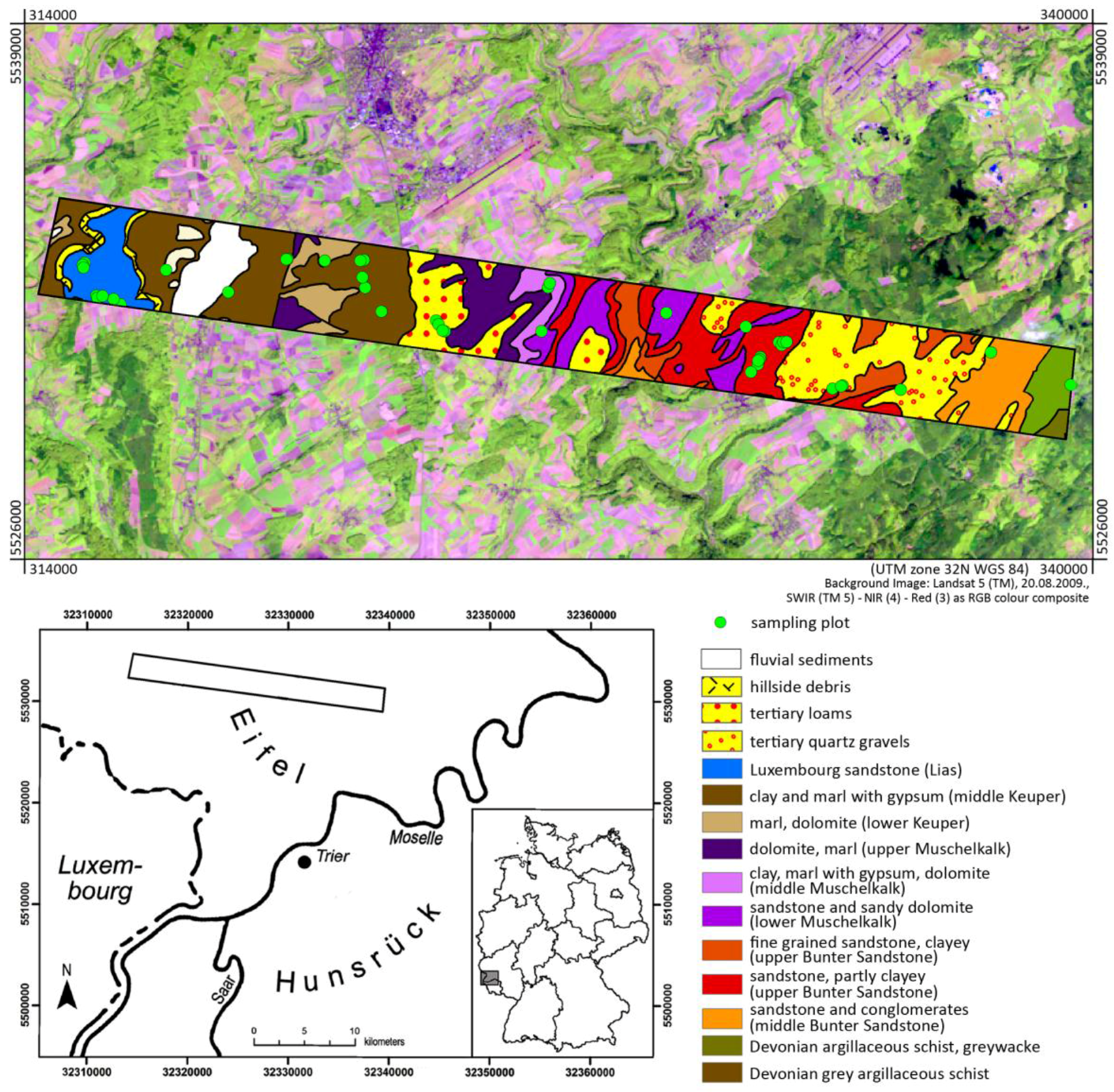
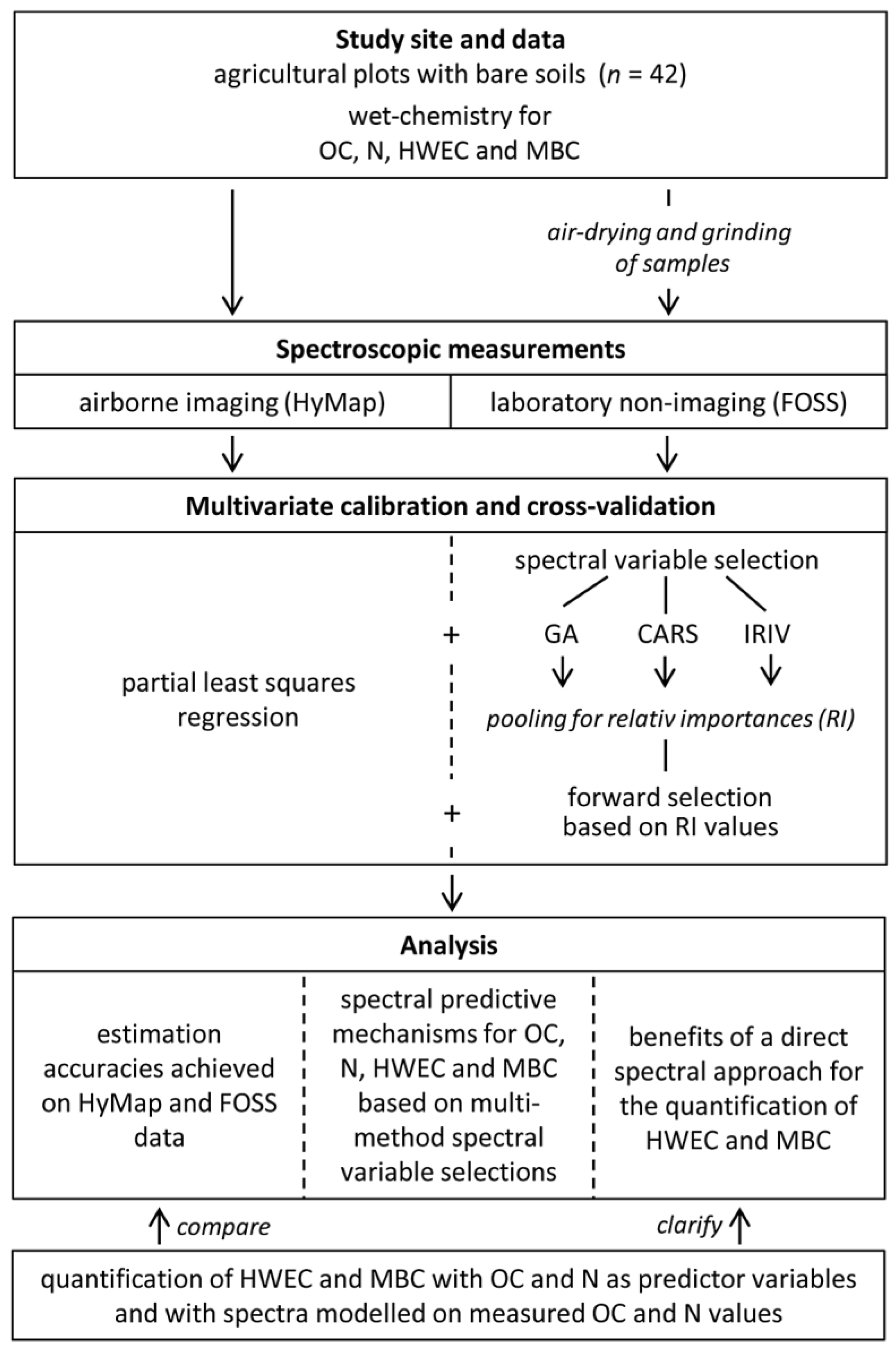
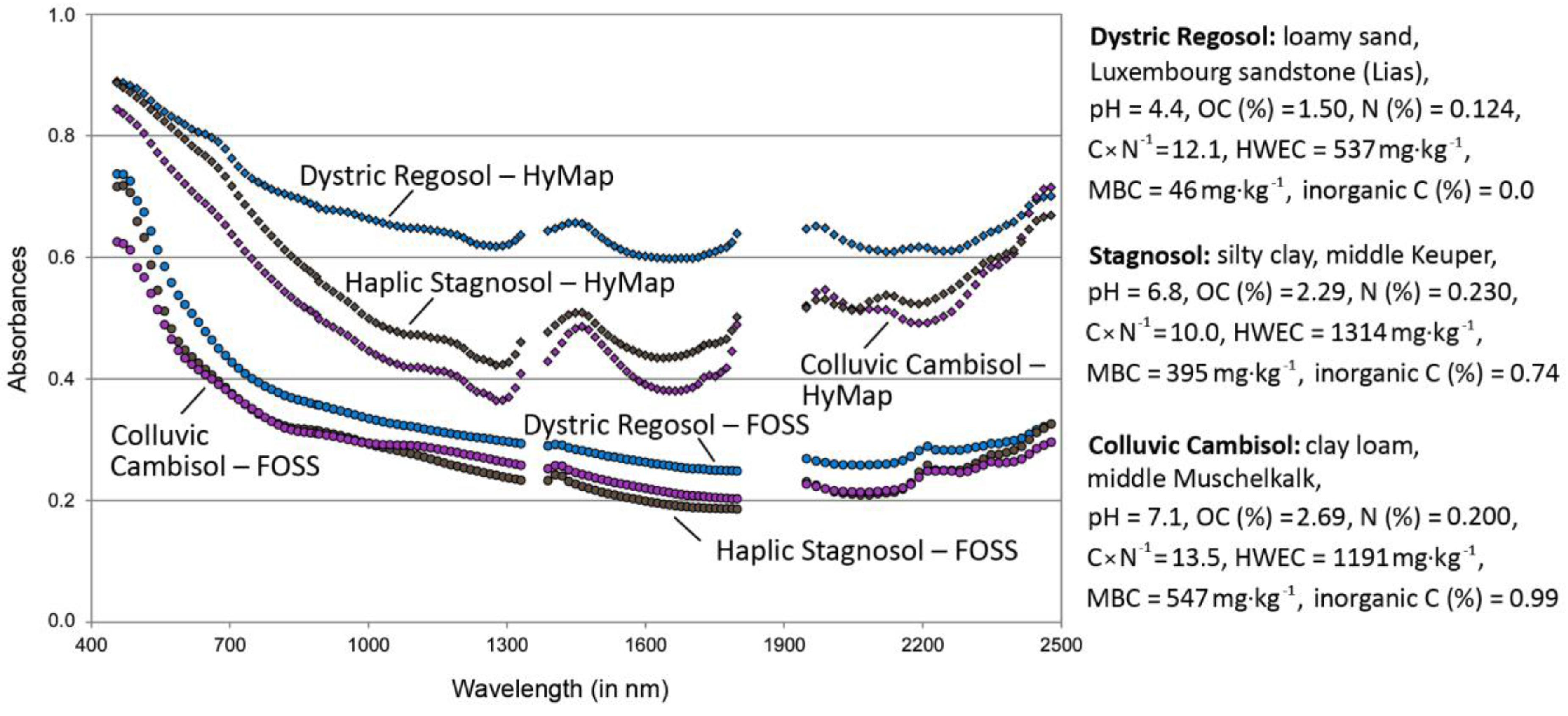

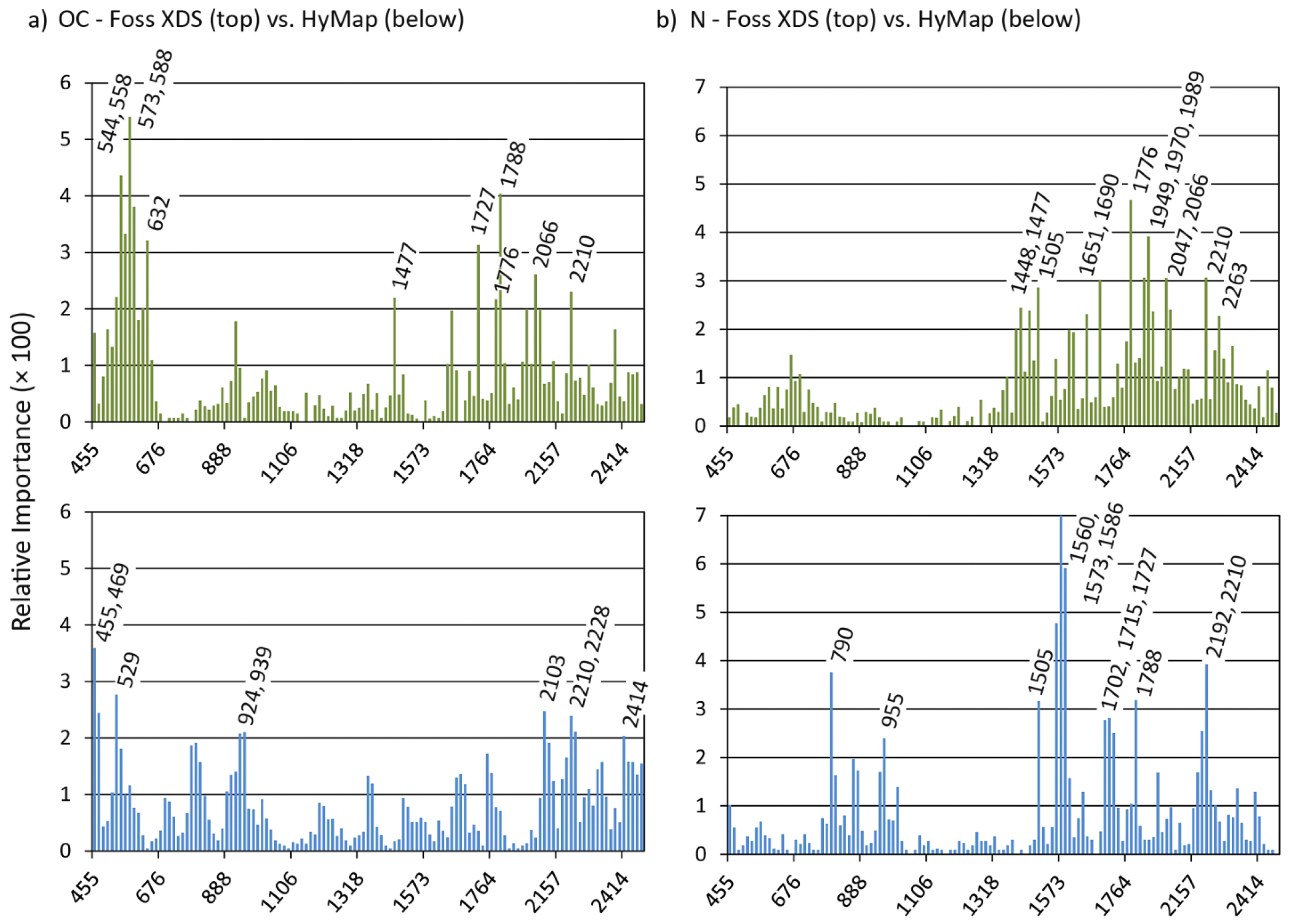
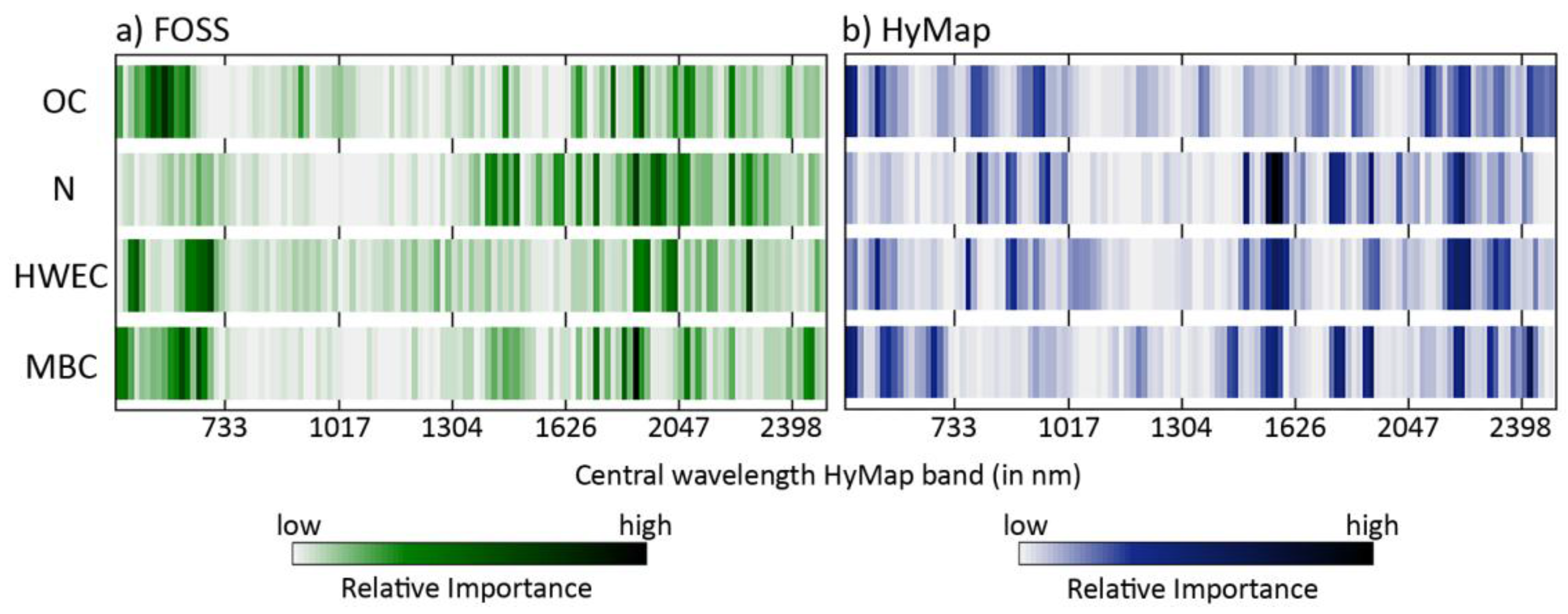
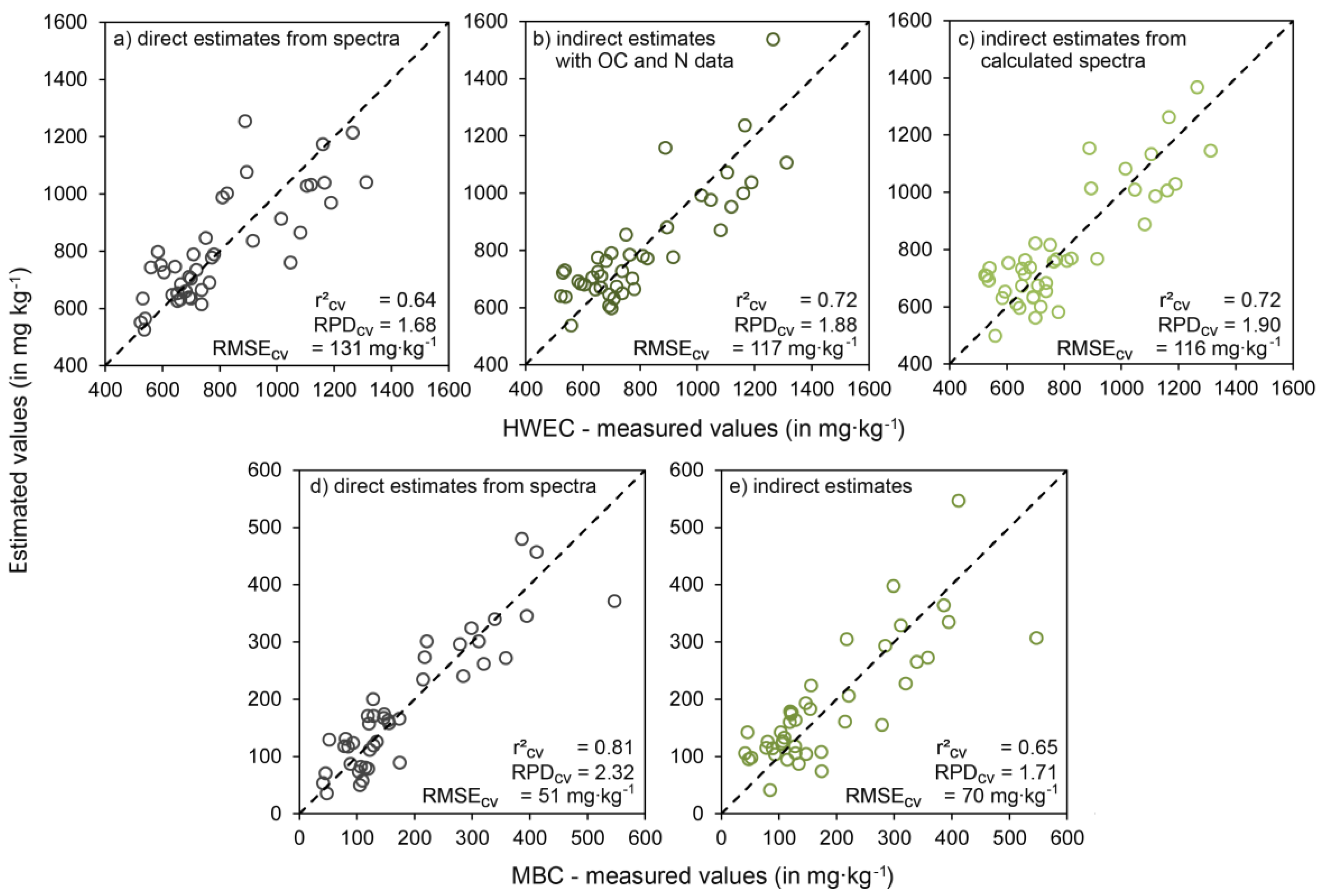
| Mean | Median | Range | Standard Deviation | |
|---|---|---|---|---|
| OC (%) | 1.76 | 1.56 | 1.09–3.01 | 0.49 |
| N (%) | 0.14 | 0.12 | 0.08–0.31 | 0.12 |
| C × N−1 | 12.8 | 13.1 | 7.74–18.0 | 2.19 |
| HWEC (mg·kg−1) | 802 | 729 | 524–1314 | 221 |
| MBC (mg·kg−1) | 184 | 132 | 41.9–547 | 119 |
| MBC × OC−1 (%) | 0.98 | 0.84 | 0.28–2.03 | 0.45 |
| Carbonate-C (%) a | 0.16 | 0 | 0–1.55 | 0.36 |
| pH (CaCl2) | 5.29 | 5.80 | 4.33–7.23 | 0.86 |
| N | HWEC | MBC | |
|---|---|---|---|
| OC | 0.80 | 0.76 | 0.78 |
| N | 0.88 | 0.82 | |
| HWEC | 0.84 |
| Soil Property | FOSS (Laboratory) | HyMap (Airborne) | ||||||||||
|---|---|---|---|---|---|---|---|---|---|---|---|---|
| l.V. a | r2cv | RMSEcv b | RPDcv | rRMSEcv | biascv c | l.V. a | r2cv | RMSEcv b | RPDcv | rRMSEcv | biascv c | |
| number of samples = 42 | ||||||||||||
| OC (%) | 12 | 0.83 | 0.21 | 2.36 | 0.12 | 0.006 | 12 | 0.73 | 0.25 | 1.94 | 0.14 | −0.005 |
| N (%) | 12 | 0.52 | 0.037 | 1.35 | 0.26 | 0.004 | 8 | 0.28 | 0.044 | 1.14 | 0.31 | −0.0004 |
| HWEC (mg·kg−1) | 6 | 0.33 | 183 | 1.20 | 0.23 | 3.8 | 12 | 0.44 | 170 | 1.30 | 0.21 | −4.7 |
| MBC (mg·kg−1) | 7 | 0.48 | 89 | 1.33 | 0.49 | 7.5 | 10 | 0.56 | 80 | 1.50 | 0.43 | 0.2 |
| number of samples = 41 | ||||||||||||
| OC (%) | 12 | 0.79 | 0.23 | 2.11 | 0.13 | 0.001 | 11 | 0.71 | 0.26 | 1.89 | 0.15 | −0.007 |
| N (%) | 10 | 0.68 | 0.029 | 1.77 | 0.20 | 0.001 | 12 | 0.49 | 0.037 | 1.35 | 0.26 | −0.0002 |
| HWEC (mg·kg−1) | 10 | 0.53 | 155 | 1.41 | 0.19 | −9.8 | 12 | 0.53 | 155 | 1.42 | 0.19 | −16.3 |
| MBC (mg·kg−1) | 7 | 0.61 | 76 | 1.57 | 0.41 | 4.1 | 12 | 0.73 | 62 | 1.94 | 0.33 | −0.6 |
| Selection Method | FOSS (Laboratory) | HyMap (Airborne) | |||||||||||
|---|---|---|---|---|---|---|---|---|---|---|---|---|---|
| l.V. b | r2cv | RMSEcv c | RPDcv | rRMSEcv | biascv d | l.V. b | r2cv | RMSEcv c | RPDcv | rRMSEcv | biascv d | ||
| OC a | CARS | 9 (15) | 0.89 | 0.16 | 3.06 | 0.09 | <0.001 * | 10 (24) | 0.76 | 0.24 | 2.04 | 0.14 | −0.006 |
| IRIV | 11 (19) | 0.93 | 0.13 | 3.72 | 0.07 | 0.004 | 9 (22) | 0.76 | 0.24 | 2.05 | 0.13 | −0.001 | |
| GA | 9 (11) | 0.94 | 0.12 | 4.08 | 0.07 | 0.002 | 10 (14) | 0.85 | 0.19 | 2.62 | 0.11 | −0.004 | |
| pooled | 10 (36) | 0.89 | 0.16 | 3.08 | 0.09 | 0.007 | 10 (63) | 0.79 | 0.22 | 2.20 | 0.13 | −0.005 | |
| N a | CARS | 9 (12) | 0.80 | 0.023 | 2.21 | 0.16 | >−0.001 * | 7 (12) | 0.55 | 0.033 | 1.50 | 0.23 | >−0.001 * |
| IRIV | 9 (13) | 0.81 | 0.021 | 2.34 | 0.15 | <0.001 * | 6 (8) | 0.57 | 0.033 | 1.54 | 0.23 | >−0.001 * | |
| GA | 10 (11) | 0.93 | 0.014 | 3.70 | 0.10 | <0.001 * | 7 (9) | 0.70 | 0.027 | 1.86 | 0.19 | >−0.001 * | |
| pooled | 9 (14) | 0.78 | 0.023 | 2.15 | 0.16 | −0.001 * | 8 (9) | 0.52 | 0.035 | 1.43 | 0.25 | 0.001 | |
| HWEC a | CARS | 9 (15) | 0.60 | 138 | 1.59 | 0.17 | >−1 * | 7 (11) | 0.67 | 125 | 1.76 | 0.16 | 1 |
| IRIV | 5 (9) | 0.42 | 166 | 1.33 | 0.21 | 6 | 8 (11) | 0.63 | 134 | 1.65 | 0.17 | >−1 * | |
| GA | 5 (5) | 0.73 | 114 | 1.94 | 0.14 | 1 | 11 (14) | 0.86 | 82 | 2.68 | 0.10 | 1 | |
| pooled | 10 (10) | 0.64 | 131 | 1.68 | 0.16 | <1 | 12 (17) | 0.67 | 128 | 1.72 | 0.16 | 3 | |
| MBC a | CARS | 8 (8) | 0.70 | 64 | 1.85 | 0.35 | 1.0 | 10 (21) | 0.72 | 62 | 1.92 | 0.34 | −0.6 |
| IRIV | 7 (15) | 0.78 | 56 | 2.13 | 0.30 | 2.2 | 10 (20) | 0.83 | 48 | 2.49 | 0.26 | <0.1 * | |
| GA | 7 (7) | 0.84 | 48 | 2.50 | 0.26 | 1.5 | 10 (12) | 0.86 | 44 | 2.68 | 0.24 | −0.5 | |
| pooled | 12 (14) | 0.81 | 51 | 2.32 | 0.28 | 0.4 | 9 (19) | 0.80 | 51 | 2.35 | 0.28 | −0.2 | |
| FOSS XDS (Laboratory) | HyMap (Airborne) | |||
|---|---|---|---|---|
| HWEC | Vis: SWIR: | 484, 499, 632, 647, 661, 676, 690 1776, 1788, 1798, 2008, 2027, 2263 | Vis: SWIR: | 529, 762, 875 1560, 1573, 1586, 1599, 2175, 2192, 2210, 2228, 2314 |
| MBC | Vis: SWIR: | 455, 469, 588, 603, 618, 632, 661, 676 1690, 1752, 1776, 2066, 2430, 2447 | Vis: SWIR: | 455, 469, 544, 558, 676 1477, 1560, 1573, 1715, 1727, 1776, 1788, 2192, 2210, 2297, 2414 |
| Soil Property | Predictors | r2cv | RMSEcv a | RPDcv | rRMSEcv | biascv b |
|---|---|---|---|---|---|---|
| HWEC | chemical data (OC, N) | 0.72 | 117 | 1.88 | 0.15 | 2 |
| (mg·kg−1) | estimates of OC, N (obtained with FOSS 1) | 0.58 | 143 | 1.55 | 0.18 | −1 |
| estimates of OC, N (obtained with HyMap 1) | 0.57 | 142 | 1.55 | 0.18 | −2 | |
| modeled FOSS spectra 2 | 0.72 | 116 | 1.90 | 0.15 | 1 | |
| modeled HyMap spectra 2 | 0.72 | 117 | 1.88 | 0.15 | 2 | |
| MBC | chemical data (OC, N) | 0.65 | 70 | 1.71 | 0.38 | 0.7 |
| (mg·kg−1) | estimates of OC, N (obtained with FOSS 1) | 0.59 | 76 | 1.56 | 0.41 | 0.4 |
| estimates of OC, N (obtained with HyMap 1) | 0.48 | 85 | 1.40 | 0.46 | −0.5 | |
| modeled FOSS spectra 2 | 0.65 | 70 | 1.71 | 0.38 | 0.7 | |
| modeled HyMap spectra 2 | 0.65 | 70 | 1.71 | 0.38 | 0.7 |
© 2017 by the authors. Licensee MDPI, Basel, Switzerland. This article is an open access article distributed under the terms and conditions of the Creative Commons Attribution (CC BY) license (http://creativecommons.org/licenses/by/4.0/).
Share and Cite
Vohland, M.; Ludwig, M.; Thiele-Bruhn, S.; Ludwig, B. Quantification of Soil Properties with Hyperspectral Data: Selecting Spectral Variables with Different Methods to Improve Accuracies and Analyze Prediction Mechanisms. Remote Sens. 2017, 9, 1103. https://doi.org/10.3390/rs9111103
Vohland M, Ludwig M, Thiele-Bruhn S, Ludwig B. Quantification of Soil Properties with Hyperspectral Data: Selecting Spectral Variables with Different Methods to Improve Accuracies and Analyze Prediction Mechanisms. Remote Sensing. 2017; 9(11):1103. https://doi.org/10.3390/rs9111103
Chicago/Turabian StyleVohland, Michael, Marie Ludwig, Sören Thiele-Bruhn, and Bernard Ludwig. 2017. "Quantification of Soil Properties with Hyperspectral Data: Selecting Spectral Variables with Different Methods to Improve Accuracies and Analyze Prediction Mechanisms" Remote Sensing 9, no. 11: 1103. https://doi.org/10.3390/rs9111103




